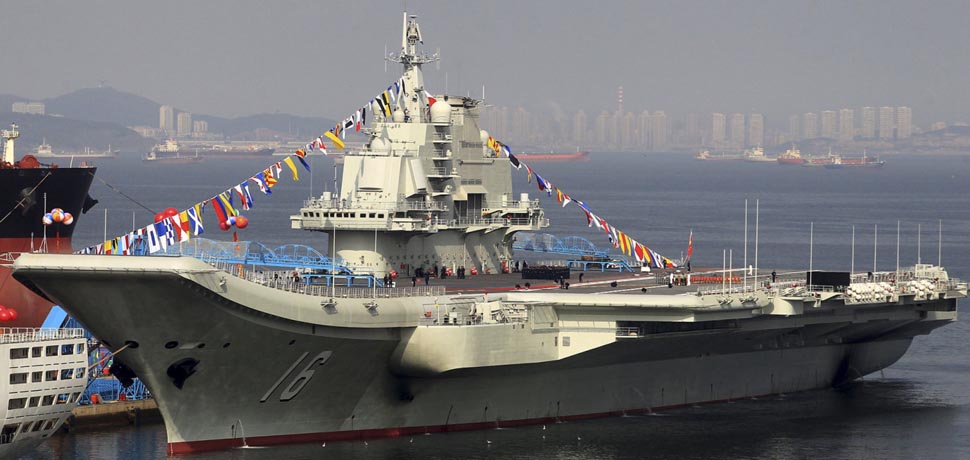Summary
In the naval power balance of the Asia-Pacific, three powers play fundamental roles: China on one side, Japan and the US on the other. In this context, China is upgrading the naval branch of its military, officially known as the People’s Liberation Army Navy (PLA Navy). This article will examine China’s efforts to increase its maritime power by examining prominent aspects of the PLA Navy’s ongoing modernization efforts.
Background
There is an ongoing debate over who is balancing whom in Northeast Asia. In reality, everything depends on your definition of “balance of power.” Some say that China is upgrading its military capabilities to match the US-Japan alliance and create a real balance in the region, meaning a situation of equilibrium where both sides have the same strength; while others claim that the PRC is challenging the existing status quo and that Japan’s own naval modernization is intended to preserve the longstanding preponderance of the US-Japan alliance. What is certain is that China’s approach to maritime warfare has evolved, and the PRC has invested enormous resources into improving its capabilities in this domain.
The strategic concept driving China’s military modernization is “offshore defense.” Its goal is to project power farther from the Chinese mainland in order to deter hostile (notably American) interventions in regional conflicts in and around the South China Sea (SCS), Taiwan, or the East China Sea (ECS). This is to be achieved by applying two key principles. The first is “informatization,” indicating the implementation of new information technologies to improve command & control activities, communication, and targeting. The second is “non-contact warfare,” which means using long-range precision weapons to engage and neutralize enemy targets. Operationally, this resulted in the gradual development of an Anti-Access / Area Denial (A2/AD) strategy, a Western term indicating the ability to deter a foreign intervention or, if dissuasion fails, to delay and disrupt it.
This strategy meets China’s immediate strategic requirements. The PRC needs to protect the sea lines of communication (SLOC) that are vital for its trade and energy supply. Moreover, China wants the means to support its territorial claims in both the SCS and the ECS, to enforce Taiwan’s reunification if necessary, and in general to pursue its interests abroad. Finally, becoming a major naval power allows China to show its strength and status. As such, Beijing has undertaken a still-ongoing naval modernization program: old vessels are being replaced by larger, more advanced and capable ones; but in most categories the total number has not changed much. Yet, this overhaul is still gradually changing the balance of power in the Asia-Pacific.
The first notable development in China’s maritime arsenal does not pertain to the PLA Navy but to the Chinese Coast Guard (CCG). Its fleet of large patrol ships (cutters) has greatly increased since 2010, doubling from 60 boats to more than 130 and making the CCG the largest coast guard in the world. Most of these units are equipped with cannons and can host a helicopter, even being capable of out-of-area operations. In addition, the CCG deploys 70 fast patrol combatants plus hundreds of smaller boats. Another 25-30 boats are expected to enter service by 2020. Even though these units are relatively small and lightly-armed (or even unarmed), they are in some sense the most important assets in China’s maritime build-up since they are used in daily activities to assert China’s claims in the SCS and elsewhere. Their size and capabilities are generally far superior to the coast guard boats or fishing trawlers from other countries involved in the dispute, giving the PRC a greater coercive power and an important advantage in case of clashes, all without crossing the “red line” of employing military forces.
But in case the CCG is not enough, then the PLA Navy can support it. For such low-intensity operations, it deploys around 60 Houbei (Type 022) missile patrol crafts that feature a modern stealthy design and carry eight YJ-83/C-802 anti-ship cruise missiles (ASCM). These ships may eventually be substituted by the newer and larger corvettes (light frigates) of the Jiangdao class (Type 056). The PRC had no such units until 2014, but 41 were commissioned by 2018 and reports indicate they will soon reach 60 boats. These vessels are equipped with several cannons, YJ-83 missiles, torpedoes, anti-aircraft systems, and a helicopter landing area. The most recent models (Type 056A) also have anti-submarine warfare (ASW) capabilities, a notable feature in the shallow waters of the SCS. A wide array of surface ships completes the fleet. Among them, three new classes are most notable: the Type 954A (Jiangkai II) frigates, the Type 052D (Luoyang III) destroyers and the Type 055 (Renhai) cruisers / large destroyers. These are all modern units equipped with advanced sensors, ASMC, and anti-aircraft systems; but they still lack adequate ASW capabilities. Several Unmanned Surface Vehicles (USVs) are also being developed as a complement.
Another important element in China’s maritime strategy is its diesel-electric attack submarines. They are optimized for anti-surface warfare (ASUW), while their anti-submarine capabilities are limited. These are used mainly for regional-level missions, notably as an A2/AD asset against US carrier battlegroups or to protect the SLOC. The most prominent class is the Yuan (Type 039A/B/C, sometimes referred to as Type 041). These are an evolution of the Type 039 / Song class, from which they differ because they are much quieter and because they feature an air-independent propulsion (AIP) system which allows the submarine to remain submerged for longer periods (two-to-three weeks, provided it maintains a low speed) thus greatly enhancing its stealth and survivability, whereas ordinary diesel-electric subs must frequently come close to the surface for snorkeling with the noisy diesel engines to recharge their electric batteries. Both Yuan and Song units can launch ASCM (notably the YJ-18 with a range of 540 kilometers) plus torpedoes and naval mines. It is not clear how many Yuan boats are in service, but estimates vary around 12-15 units with a total 20 new ones expected. Other notable boats are the two Russian-made submarines of the improved Kilo class (Project 636 Varshavyanka). Apart from carrying the powerful long-range SS-N-27 ‘Sizzler’ ASCM, they have an extremely low sonar signature and are probably the PLA Navy’s quietest submarines. In 2016, the total size of China’s conventionally-propelled undersea force was of 57 boats, expected to reach 63 in 2020. These units have a great value as A2/AD assets due to their low detectability, which makes them a real threat for American and Japanese units (even though both have advanced ASW capabilities). In contrast, nuclear-powered units still represent a minority in the Chinese submarine fleet. Despite their greater autonomy and limited land-attack capabilities, the classes currently in service are still excessively noisy and therefore detectable. Things may change with the upcoming Type 095 class (seemingly named Sui in the West), but too little is known at the moment. To complement its manned submarine force, China is also developing Unmanned Underwater Vehicles (UUVs), including large AI-controlled boats. These units will presumably be used for intelligence, mines deployment, and also (suicide) attack missions. China is also working to implement AI-enhanced sensors on its ordinary vessels, and this could give it a significant “cognitive advantage” by enabling their crew to take faster and more informed decisions.
As far as ballistic missiles submarines are concerned, the Jin-class units (Type 094), represent China’s first credible sea-based second-strike nuclear assets. At least four are in service with more under construction. Their JL-2 missiles have a range of 7,400 kilometers or more (nearly three times the old JL-1), meaning that they could hit the Western half of the United States if launched from mid-ocean positions west of Hawaii. Still, even though they are quieter than their predecessors (Xia class / Type 092), they are still too noisy; a problem that could be solved only by the upcoming Type 096 / Tang class.
Amphibious assault ships are also a notable recent addition. China currently operates 5-6 units of the Type 071 (Yuzhao class), each capable of carrying four medium air-cushioned landing crafts, four helicopters, armored vehicles and a battalion of marines (800 men). These will soon be joined by the Type 075, larger vessels hosting a total of 30 helicopters and featuring a full-fledged flight deck. These units are a significant advancement in China’s amphibious capabilities, and they potentially enable the PLA Navy to perform landing operations to assert its territorial claims by force. However, mounting complex amphibious assaults requires competences that the Chinese still lack. As such, at the moment the scope of a hypothetic Chinese landing remains limited to the disputed islands of the SCS or the Senkaku / Diaoyu islands, while an invasion of Taiwan is still deemed beyond its capacities.
Similar considerations can be made for China’s aircraft carriers. Currently, the PLA Navy operates two similar units of Russian design: the Type 001 (Liaoning) and the Type 001A (Shandong). Even though they represent real progress, they still suffer from serious limitations when compared to their American counterparts. Being conventionally-powered ships, their operational range is inferior. They carry fewer and less capable aircraft, both in terms of fighters and auxiliaries like Airborne Early Warning and Control (AEW&C) planes. The ski-jump configuration of the deck reduces the payload the aircraft can carry. Finally, China is still in the early stages of developing the know-how for conducting carrier operations, and for the time being its carriers are not ready for “blue water” operations and for projecting power far from the mainland. Yet they are a valuable foundation upon which the PLA Navy can build its expertise in carrier operations. It is projected that the PLA Navy will field 4-6 carriers in total, and upcoming units are expected to be more similar to US ones, featuring catapult aircraft launch systems, nuclear propulsion, and the facilities to host more advanced planes in greater numbers.
Other assets also play an important role. The DF-21D anti-ship ballistic missile is probably the most discussed A2/AD weapon of the PRC. It carries a Maneuverable Reentry Vehicle (MaRV), which makes interception particularly difficult, and is allegedly capable of hitting a moving ship from 1,500 kilometers. Its fellow-up, the DF-26, has a range of 4,000 kilometers. China could also equip them with the new DF-ZF Hypersonic Glide Vehicle (HGV), which would make interception practically impossible. Various ASCM are also in use. Finally, China has an estimated stockpile of 50,000 naval mines of various types, which would be extremely effective to block strategic areas like ports or maritime chokepoints.
Forecast
It is clear that China’s naval modernization effort is largely aimed at obtaining the means to assert its interests in the neighboring seas and to counter the US-Japan alliance. The PRC will continue along this line, and four domains are likely to be prioritized in the coming years: filling the gap in anti-submarine operations, enhancing the survivability of its ballistic missile submarines (and therefore the credibility of its sea-based nuclear deterrence), improving its amphibious assault capabilities, and expanding its global reach. But in the typical strategic dialectic, the US and Japan will not stand still and will work to adapt their own forces in response. As a matter of fact, they are already doing so, as the next article in this series will show.




